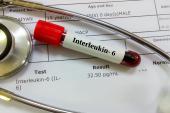Variable Response to Novel PCSK9 Inhibitor Lerodalcibep in LIBERATE-HoFH
It isn’t necessarily a bad news story, say experts, noting that many HoFH patients had a decent response to PCSK9 inhibition.

MANNHEIM, Germany—Response to treatment is highly variable with the investigational PCSK9 inhibitor lerodalcibep (LIB Therapeutics), as well as with evolocumab (Repatha; Amgen), in patients who have homozygous familial hypercholesterolemia (HoFH), according to results from a new study presented this week at the European Atherosclerosis Society (EAS) Congress 2023.
Among patients with genetically confirmed HoFH, lerodalcibep reduced LDL-cholesterol levels by 9.26% after 24 weeks of treatment whereas evolocumab cut LDL by 11.0%, a nonsignificant difference.
Lead investigator Frederick J. Raal, MD (University of the Witwatersrand, Johannesburg, South Africa), said the phase III study, LIBERATE-HoFH, was intended to see if the novel lerodalcibep could produce a better treatment effect in a patient population known to have a highly variable response to lipid-lowering therapy with PCSK9 monoclonal antibodies such as evolocumab.
“In theory, monoclonal antibodies mop up all PCSK9, but the hope would be that because lerodalcibep reduces PCSK9 by roughly 90%, it might have been more effective than the others,” Raal told TCTMD. “What this showed is that it’s actually the patient that determines the response.”
In this study, poor responders to evolocumab were also poor responders to lerodalcibep, he said.
The results, however, are not completely disappointing, say investigators, noting that one-quarter of lerodalcibep-treated patients and a little more than one-third of evolocumab-treated patients had a clinically meaningful 15% or greater reduction in LDL cholesterol levels. In a high-risk population that struggles to get to treatment goals, that is a positive finding.
“Given the marked reduction in one-third of the patients, PCSK9 inhibitors remain part of standard care for our patients with homozygous FH,” said Raal. “Some patients do respond, so I think it’s worth giving it a try, one or two doses, and seeing how the patients do.”
Samuel Gidding, MD (Nemours Children’s Hospital, Wilmington, DE), who wasn’t involved in the study, said there’s a “huge” variability with response to PCSK9 inhibitors in HoFH patients, with the drugs working for 50% or fewer individuals.
“But if they work, they’re very effective,” he told TCTMD, adding that drug efficacy can be affected by other therapies. “As Dr. Raal suggested, the trial-and-error approach really is the best way to go. We don’t know enough to predict what’s going to happen. The flip side of that is that once you have data, you should follow it. If you know they’re not responding to a specific drug, you shouldn’t be afraid to take them off it because we have lots of different drugs with different mechanisms.”
Trial With PCSK9 Inhibitors
HoFH is a rare but very serious form of familial hypercholesterolemia that can result in untreated LDL-cholesterol levels ranging from 400 to 1,000 mg/dL, which in turn lead to early-onset atherosclerosis and atherosclerotic cardiovascular disease (ASCVD). An updated EAS consensus statement recommends physicians start patients on a high-intensity statin plus ezetimibe as first-line therapy, to be followed by a PCSK9 inhibitor at 8 weeks. If a clinically meaningful response to the PCSK9 inhibitor is not achieved after one or two doses, physicians are advised to stop treatment and consider lomitapide (Juxtapid/Lojuxta; Aegerion Pharmaceuticals) and/or ANGPTL3-directed therapy (with or without lipoprotein apheresis) if the patient isn’t at goal.
Lerodalcibep differs from approved monoclonal antibodies in that it consists of a small recombinant fusion protein of a PCSK9-binding domain and human serum albumin. Adnectin, the target-binding protein, fastens to PCSK9 to prevent it from interacting with the LDL receptor; this then prevents degradation of the LDL receptors that are responsible for cholesterol clearance.
As Raal pointed out, the researchers wanted to test lerodalcibep in HoFH patients as it had been shown in previous phase II studies to be highly effective in reducing PCSK9 and LDL-cholesterol levels.
What this showed is that it’s actually the patient that determines the response. Frederick J. Raal
LIBERATE-HoFH was a phase III, open-label, crossover study that included patients 10 years or older (mean age 29 years; 55% female) treated with oral lipid-lowering agents randomized to lerodalcibep 300 mg or evolocumab 420 mg, both of which were administered subcutaneously every 4 weeks. All patients were treated with a statin—95% with a high-intensity statin—and 95% were also taking ezetimibe. One third of patients had established ASCVD, and nearly 20% had aortic stenosis and/or prior aortic valve replacement.
At baseline, mean LDL-cholesterol levels were 10.35 mmol/L (400.2 mg/dL) in both groups. By week 24, both lerodalcibep and evolocumab reduced LDL-cholesterol levels by approximately 10% but there was no significant difference between treatments. There were several patients who had a more than 60% reduction in LDL levels with evolocumab and lerodalcibep, including one who had an 80% reduction from baseline with both drugs. Interestingly, some of the patients with null-null LDL-receptor mutations, which would result in them having little to no LDL receptor function, responded to treatment.
“In fact, the best responder was a null-null patient,” said Raal, highlighting the unexpected and unpredictable responses. “For the individual patient, there must be other factors; it’s really hard to predict a response.”
Treatment was generally well tolerated, with no difference in drug-related moderate or severe adverse events between groups and no patient deaths. Injection-site reactions were more common with evolocumab.
For Stephen Nicholls, MBBS, PhD (Monash University, Melbourne, Australia), who wasn’t involved in the study, the most interesting aspect of LIBERATE-HoFH is the large reduction in LDL cholesterol seen in some patients with virtually no LDL receptor function, which suggests “we don’t know all that we think we know” about PCSK9 inhibition in HoFH patients. That a small proportion of patients responded to treatment with both drugs is encouraging, he told TCTMD, noting that lerodalcibep is a small-volume therapeutic (~ 1 mL), which would hopefully limit injection-site reactions.
Variable Response Also Seen in Pediatrics
In an earlier presentation, Raal also presented pooled data from three trials (HAUSER-OLE, TAUSSIG, and RAMAN) of pediatric patients treated with PCSK9 inhibition. In total, 39 patients aged 10 to 17 years who had a genetic or clinical diagnosis of HoFH were treated with evolocumab on top of mostly high-intensity statin therapy and ezetimibe. At baseline, the mean LDL-cholesterol levels were 11.7 mmol/L (452.4 mg/dL) in 35 patients who weren’t undergoing lipoprotein apheresis and 8.7 mmol/L (336.4 mg/dL) in apheresis-treated patients.
In those who weren’t treated with apheresis, evolocumab reduced LDL levels by 2.9% from baseline. For the handful of patients who were treated with apheresis, evolocumab had no benefit, with LDL increasing by 10.7%. Like in LIBERATE-HoFH, the researchers also found marked variability in response to treatment. For the 35 patients without prior apheresis, 43% were able to achieve a 15% or greater reduction in LDL-cholesterol levels on evolocumab.
When researchers looked at the percent change in LDL cholesterol by the estimated LDL-receptor activity (based on the genetic mutation), the response to treatment was also quite variable.
In general, Raal said physicians have a lot of difficulty getting HoFH patients to goal, adding that even with statins, ezetimibe, and a PCSK9 inhibitor, “we’re still not going to get many of the patients to the [LDL] levels we need to get them.” In adults, that goal is less than 55 mg/dL if they have ASCVD or other major risk factors or less than 70 mg/dL if they don’t (for children, the goal is less than 115 mg/dL). He is hopeful that with quadruple therapy, which would include an ANGPTL3 inhibitor like evinacumab (Evkeeza; Regeneron), most patients would get close to the target.
“Our biggest problem is that all of these newer therapies that are coming on board have only been [tested] in homozygous patients aged 18 years [and older],” said Raal. “We really need to start these therapies much earlier.”
Outside of HoFH, Nicholls said one challenge with the development of newest PCSK9 inhibitor lerodalcibep will be where it fits in the clinical landscape. There will be a need for a clinical outcomes trial, he told TCTMD, at which point the monoclonal antibodies will have been available for many years, as will inclisiran (Leqvio; Novartis).
“The onus is going to be on that program to demonstrate where the value added is compared with lots of other options that are also in the clinic, keeping in mind that there’s an oral PCSK9 inhibitor that’s also being developed as well,” said Nicholls.
Michael O’Riordan is the Managing Editor for TCTMD. He completed his undergraduate degrees at Queen’s University in Kingston, ON, and…
Read Full BioSources
Raal F, Mehta V, Kayikcioglu M, et al. Randomized, open-label, cross-over phase-3 study to evaluate the efficacy and safety of LIB003 (lerodalcibep) compared with evolocumab in homozygous familial hypercholesterolemia patients on stable lipid-lowering therapy (LIBERATE-HoFH). Presented at: EAS 2023. May 23, 2023. Mannheim, Germany.
Raal FJ, Ruzza A, López JAG, et al. Evolocumab treatment in pediatric patients with homozygous familial hypercholesterolemia: data from three pooled, open-label studies. Presented at: EAS 2023. May 23, 2023. Mannheim, Germany.





Comments